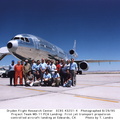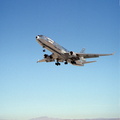
WIKIARCHIVES.SPACE
The Human Spaceflight Archive

On Aug. 30, 1995, a the McDonnell Douglas MD-11 transport aircraft landed equipped with a computer-assisted engine control system that has the potential to increase flight safety.
Information
- Taken in
- Edwards Air Force Base
- Tekijä
- NASA
- Kuvaus
-
On Aug. 30, 1995, a the McDonnell Douglas MD-11 transport aircraft landed equipped with a computer-assisted engine control system that has the potential to increase flight safety.
In landings at NASA Dryden Flight Research Center, Edwards, California, on August 29 and 30, the aircraft demonstrated software used in the aircraft's flight control computer that essentially landed the MD-11 without a need for the pilot to manipulate the flight controls significantly. In partnership with McDonnell Douglas Aerospace (MDA), with Pratt & Whitney and Honeywell helping to design the software, NASA developed this propulsion-controlled aircraft (PCA) system following a series of incidents in which hydraulic failures resulted in the loss of flight controls. This new system enables a pilot to operate and land the aircraft safely when its normal, hydraulically-activated control surfaces are disabled.
This August 29, 1995, photo shows the MD-11 team. Back row, left to right: Tim Dingen, MDA pilot; John Miller, MD-11 Chief pilot (MDA); Wayne Anselmo, MD-11 Flight Test Engineer (MDA); Gordon Fullerton, PCA Project pilot; Bill Burcham, PCA Chief Engineer; Rudey Duran, PCA Controls Engineer (MDA); John Feather, PCA Controls Engineer (MDA); Daryl Townsend, Crew Chief; Henry Hernandez, aircraft mechanic; Bob Baron, PCA Project Manager; Don Hermann, aircraft mechanic; Jerry Cousins, aircraft mechanic; Eric Petersen, PCA Manager (Honeywell); Trindel Maine, PCA Data Engineer; Jeff Kahler, PCA Software Engineer (Honeywell); Steve Goldthorpe, PCA Controls Engineer (MDA). Front row, left to right: Teresa Hass, Senior Project Management Analyst; Hollie Allingham (Aguilera), Senior Project Management Analyst; Taher Zeglum, PCA Data Engineer (MDA); Drew Pappas, PCA Project Manager (MDA); John Burken, PCA Control Engineer.
- Luotu
- Tiistai 29 Elokuu 1995
- Source link
- https://www.dfrc.nasa.gov/Gallery/Photo/MD-11PCA/index.html
- Vierailut
- 69
- Pisteet
- ei arvosteltu
- Arvostele tämä kuva
- License
- Public Domain
- Modified by WikiArchives
- No (original)
- Lataukset
- 1
Powered by Piwigo









